Hiring the right candidate for your Elasticsearch needs can be challenging without the right set of questions. This blog post provides a comprehensive list of interview questions that you can use to identify top talent efficiently.
We'll cover a wide range of topics from general to advanced Elasticsearch queries, and delve into specific areas like indexing strategies and query optimization. By understanding the right set of questions for each skill level, you can streamline your interview process and select the best candidates.
Using these questions, you stand a better chance of hiring the right candidates who can contribute effectively to your team. Additionally, consider using our Elasticsearch test to pre-screen candidates before the interview.
Table of contents
8 general Elasticsearch interview questions and answers

If you're looking to gauge a candidate's understanding of Elasticsearch, this list of interview questions will be your best friend. Perfect for recruiters and hiring managers, these questions are designed to be straightforward and insightful, helping you identify the right talent for your team.
1. What is Elasticsearch and what are its primary use cases?
Elasticsearch is a highly scalable open-source search engine based on Apache Lucene. It allows you to store, search, and analyze large volumes of data quickly and in near real-time.
Common use cases for Elasticsearch include application search, website search, logging and log analysis, and real-time data analytics. It's particularly useful for tasks that require full-text search capabilities.
Ideal candidate responses should demonstrate a clear understanding of Elasticsearch's versatility and real-world applications, particularly how it can solve specific business problems.
2. How does Elasticsearch achieve near real-time search capabilities?
Elasticsearch achieves near real-time search capabilities through its indexing and search processes. When a document is indexed, it's available for search almost immediately.
This is made possible by the use of in-memory indexing and a refresh interval, which by default is set to one second. This means that any new or updated documents are quickly made available for searching within a second of indexing.
Candidates should highlight the significance of the refresh interval and in-memory indexing, as well as their impact on performance and real-time data availability.
3. Can you explain what an Elasticsearch index is?
An Elasticsearch index is a collection of documents that share similar characteristics. It is the primary unit where data is stored and retrieved in Elasticsearch.
Each index is identified by a unique name and can contain multiple types of documents, each with its own unique properties.
Look for candidates who can explain the concept clearly and relate it to practical scenarios, such as how they might organize and manage data within indices.
4. What are the advantages of using Elasticsearch over traditional relational databases?
Elasticsearch offers several advantages over traditional relational databases, including full-text search capabilities, real-time indexing and searching, and horizontal scalability.
Unlike relational databases, Elasticsearch is designed to handle large volumes of unstructured data and can easily distribute search queries across multiple nodes, improving performance and reliability.
Strong answers should mention specific scenarios where Elasticsearch outperforms relational databases, such as handling complex search queries or managing large datasets.
5. What is a shard in Elasticsearch and why is it important?
A shard is a basic unit of storage in Elasticsearch. It allows Elasticsearch to distribute data across multiple nodes, making the system scalable and resilient.
Each index can be divided into multiple shards, and each shard can have replicas for fault tolerance. This ensures that even if one node fails, the data remains accessible.
Candidates should be able to explain the role of shards in Elasticsearch's architecture and how they contribute to the system's scalability and fault tolerance.
6. How can you ensure high availability in an Elasticsearch cluster?
High availability in an Elasticsearch cluster can be achieved by setting up multiple nodes and enabling replicas for each shard. This ensures that if one node fails, the data is still accessible from other nodes.
Additionally, Elasticsearch supports automatic failover and load balancing, which helps maintain cluster stability and performance. Regular monitoring and maintenance are also crucial for ensuring high availability.
Look for candidates who can discuss the importance of replicas, failover mechanisms, and monitoring tools in maintaining a highly available Elasticsearch cluster.
7. What is the role of an Elasticsearch node, and how do different types of nodes function?
An Elasticsearch node is a single instance of Elasticsearch that stores data and participates in the cluster's indexing and search operations. There are different types of nodes, each with a specific role.
- Master nodes manage the cluster's metadata and state, such as node configurations and index settings.
- Data nodes store data and perform data-related operations like indexing and searching.
- Ingest nodes preprocess documents before indexing by applying transformations or enrichments.
Candidates should demonstrate an understanding of the different node types and their roles in maintaining an efficient and balanced Elasticsearch cluster.
8. How do you handle security in Elasticsearch?
Security in Elasticsearch can be handled through various mechanisms such as user authentication, role-based access control (RBAC), and encryption.
Elasticsearch provides built-in security features like HTTPS for encrypted communication, and the Elastic Stack offers additional tools like Kibana for monitoring and auditing.
Look for candidates who can discuss the importance of securing Elasticsearch clusters, and who are familiar with common security practices and tools.
20 Elasticsearch interview questions to ask junior developers
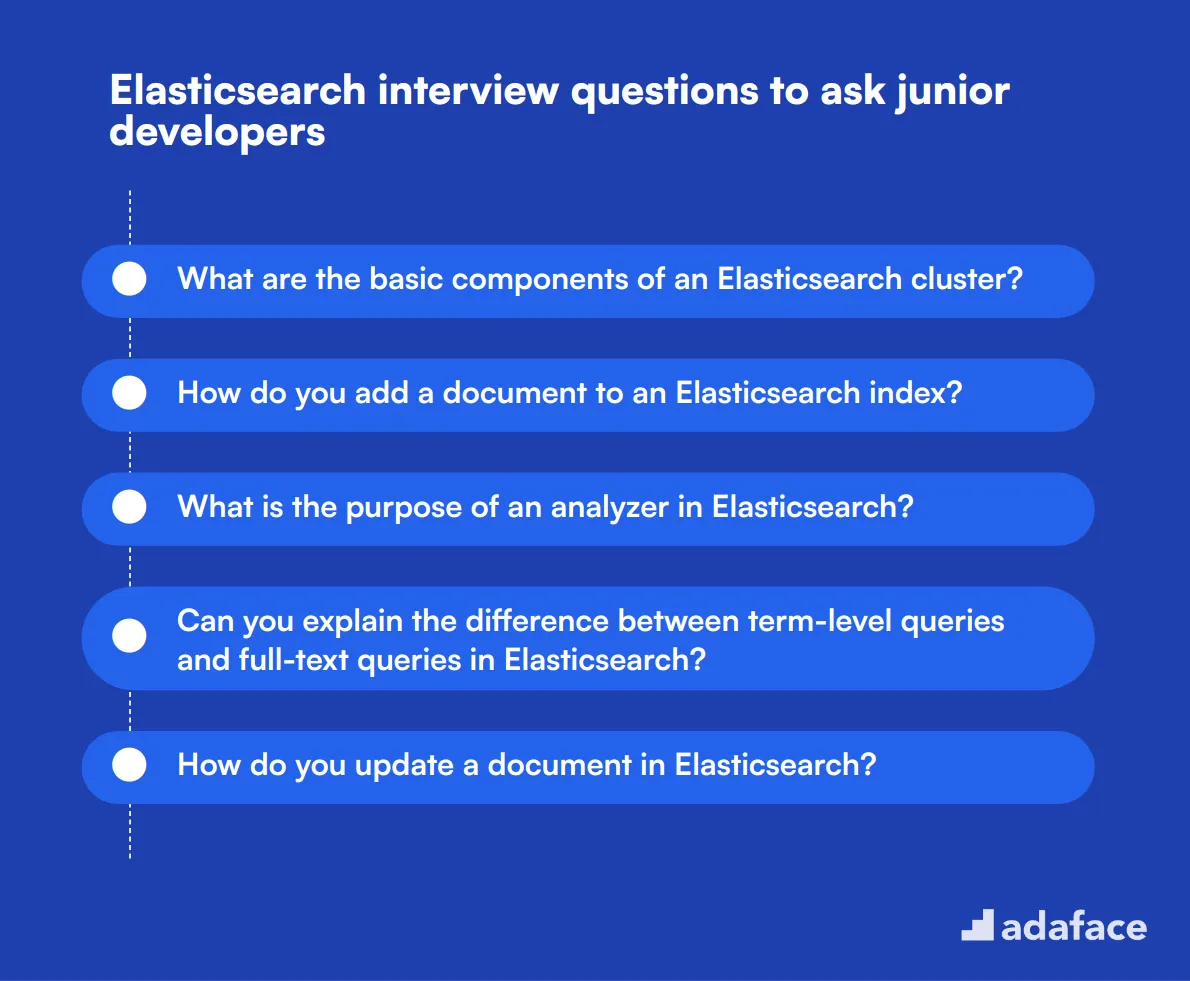
To ensure your junior developers have a solid understanding of Elasticsearch, use this list of 20 targeted interview questions. These questions are designed to help you evaluate their basic knowledge and practical skills efficiently. For additional resources on hiring technical roles, check out this Java developer job description.
- What are the basic components of an Elasticsearch cluster?
- How do you add a document to an Elasticsearch index?
- What is the purpose of an analyzer in Elasticsearch?
- Can you explain the difference between term-level queries and full-text queries in Elasticsearch?
- How do you update a document in Elasticsearch?
- What is the purpose of the 'match' query in Elasticsearch?
- How does Elasticsearch handle data replication?
- What is an Elasticsearch mapping?
- How do you delete an index in Elasticsearch?
- What is an Elasticsearch alias and how is it used?
- Can you explain the concept of 'tokenization' in Elasticsearch?
- How do you configure Elasticsearch to optimize search performance?
- What is the significance of the 'match_phrase' query in Elasticsearch?
- How would you handle large volumes of data in Elasticsearch?
- Can you describe how Elasticsearch scoring works?
- What is the purpose of the 'multi_match' query in Elasticsearch?
- How do you perform a bulk operation in Elasticsearch?
- What are 'aggregations' in Elasticsearch, and how do they work?
- How do you monitor the health of an Elasticsearch cluster?
- What steps would you take to troubleshoot performance issues in Elasticsearch?
10 intermediate Elasticsearch interview questions and answers to ask mid-tier engineers
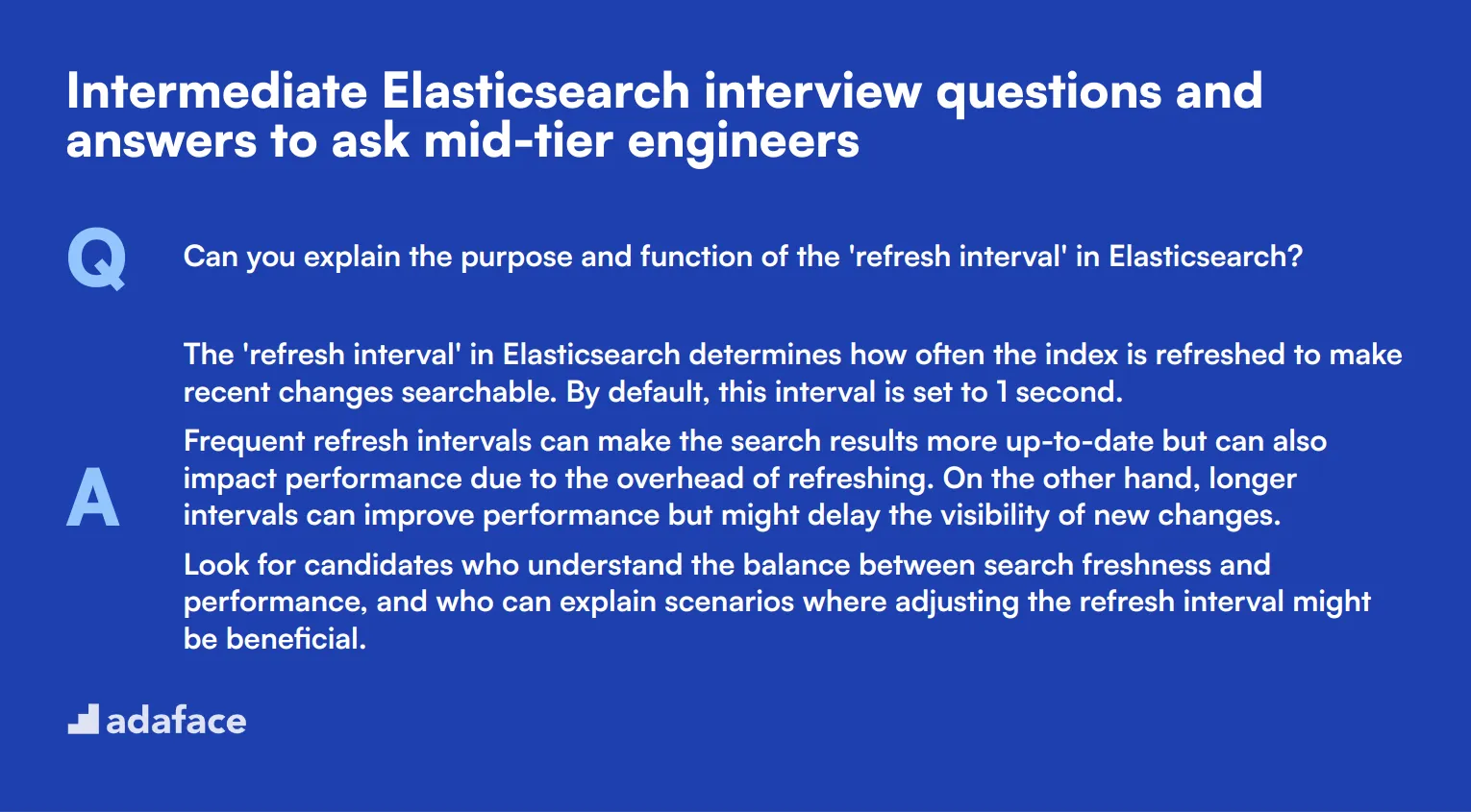
To determine whether your applicants possess the necessary technical understanding and problem-solving skills for mid-tier Elasticsearch roles, ask them some of these intermediate interview questions. This list will help you evaluate their depth of knowledge and practical experience with Elasticsearch.
1. Can you explain the purpose and function of the 'refresh interval' in Elasticsearch?
The 'refresh interval' in Elasticsearch determines how often the index is refreshed to make recent changes searchable. By default, this interval is set to 1 second.
Frequent refresh intervals can make the search results more up-to-date but can also impact performance due to the overhead of refreshing. On the other hand, longer intervals can improve performance but might delay the visibility of new changes.
Look for candidates who understand the balance between search freshness and performance, and who can explain scenarios where adjusting the refresh interval might be beneficial.
2. How would you manage a large Elasticsearch index to ensure optimal performance?
Managing a large Elasticsearch index involves several strategies, such as using proper sharding, indexing smaller documents, and leveraging index lifecycle management.
Candidates may discuss optimizing the number of shards based on data size and search patterns, using 'rollover' indices for time-based data, and setting up retention policies to manage old data efficiently.
An ideal response should demonstrate a clear understanding of the trade-offs involved and practical steps to ensure the system remains performant under large data volumes.
3. What are some common reasons for slow search performance in Elasticsearch and how would you troubleshoot them?
Common reasons for slow search performance include insufficient hardware resources, inefficient queries, improper shard allocation, and lack of indexing optimization.
Troubleshooting steps might involve analyzing query performance using tools like the 'profile API', optimizing mappings and analyzers, ensuring proper resource allocation, and monitoring cluster health statistics.
Strong candidates should show familiarity with diagnostic tools and methods for identifying bottlenecks, and should provide concrete examples of how they've resolved performance issues in the past.
4. How do you handle data reindexing in Elasticsearch when there are schema changes?
Reindexing is necessary when there are schema changes that the existing indices cannot accommodate. This involves creating a new index with the updated schema and migrating data from the old index to the new one.
Candidates might mention using the '_reindex' API, managing downtime, or ensuring minimal disruption during the reindexing process. They should also discuss strategies for validating the new index before fully switching over.
An ideal response will show a clear understanding of the reindexing process, potential challenges, and best practices to ensure data integrity and availability.
5. Can you explain the role of 'replica shards' in Elasticsearch and how they contribute to cluster reliability?
'Replica shards' are copies of the primary shards in an Elasticsearch cluster. They provide redundancy, ensuring data is not lost if a node fails.
Candidates should explain that replica shards help distribute search load and improve fault tolerance. They might also discuss the trade-offs, such as the additional storage and indexing overhead involved in maintaining replicas.
Look for responses that show a good understanding of how replica shards contribute to both data availability and cluster performance, and examples of configuring replicas based on specific requirements.
6. How would you approach scaling an Elasticsearch cluster to handle increased load?
Scaling an Elasticsearch cluster can be approached by either adding more nodes to the cluster or optimizing existing node configurations.
Candidates should discuss strategies like sharding, increasing replication, adjusting resource allocations, and possibly implementing cross-cluster search for distributed setups.
A strong answer should demonstrate a clear plan for both vertical and horizontal scaling, including considerations for hardware resources, data distribution, and query load balancing.
7. What are some best practices for designing an efficient Elasticsearch schema?
Designing an efficient Elasticsearch schema involves defining appropriate mappings for fields, choosing the right data types, and using analyzers and filters effectively.
Candidates should highlight the importance of minimizing field mappings, avoiding dynamic mapping where possible, and using nested and object fields judiciously.
An ideal candidate will provide examples of schema design that balances performance, storage efficiency, and search accuracy, and can explain how they avoid common pitfalls like mapping explosion.
8. Can you discuss the importance of index templates in Elasticsearch and how you use them?
Index templates in Elasticsearch allow you to define settings, mappings, and aliases that will be applied automatically to new indices that match a given pattern.
This is particularly useful for maintaining consistency across multiple indices, especially in environments where new indices are created frequently, such as logging or time-series data.
A good answer will demonstrate an understanding of how to create and manage index templates, along with examples of how they’ve used templates to automate and streamline index management.
9. How would you implement a backup and restore strategy for an Elasticsearch cluster?
Implementing a backup and restore strategy involves using the snapshot and restore API to periodically capture snapshots of your indices and store them in a repository like AWS S3 or a shared filesystem.
Candidates should discuss the importance of scheduling regular snapshots, ensuring the backup repository's security, and regularly testing restore procedures to ensure data integrity.
Look for candidates who can explain best practices for backup frequency, repository management, and how they handle different disaster recovery scenarios.
10. What methods can you use to monitor Elasticsearch performance and health?
Monitoring Elasticsearch performance and health can be done using tools like Kibana, Elasticsearch's own monitoring APIs, and third-party solutions like Prometheus and Grafana.
Candidates should mention key metrics to monitor, such as cluster status, node statistics, shard allocation, and search/query performance.
An ideal response will demonstrate an understanding of setting up alerts for critical conditions and provide examples of how they’ve used monitoring tools to proactively manage and troubleshoot cluster issues.
18 advanced Elasticsearch interview questions to ask senior architects
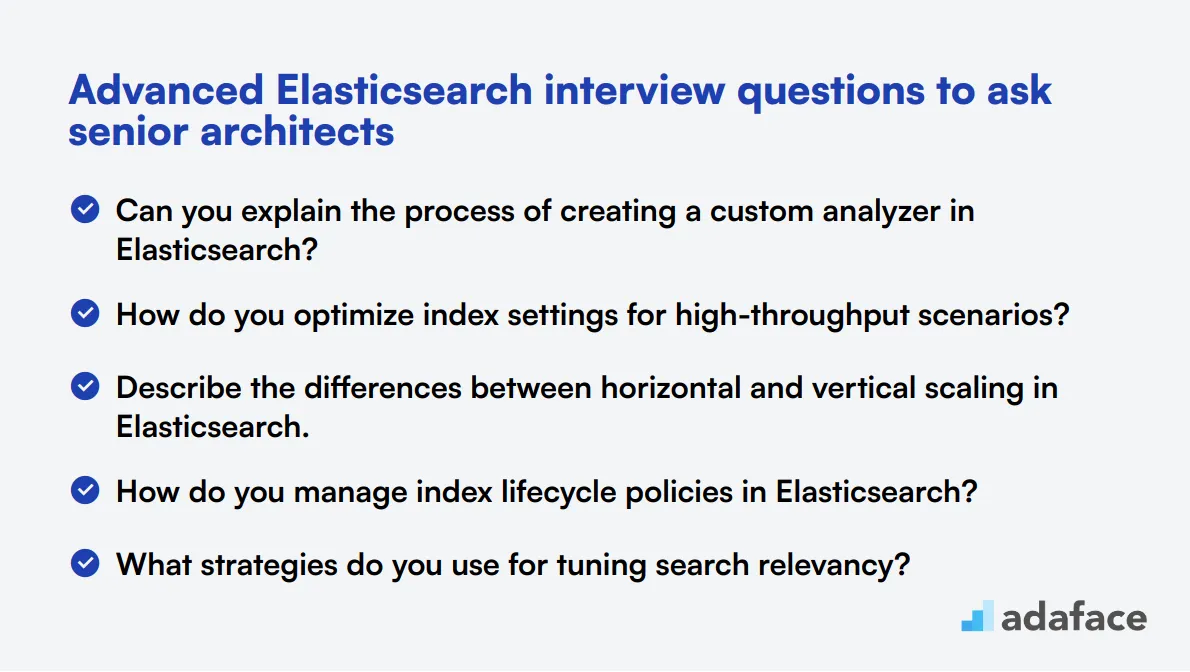
To ensure your candidates have the advanced technical knowledge needed for Elasticsearch, use these questions during your interviews. This list will help you gauge their ability to handle complex tasks and make effective use of Elasticsearch in real-world scenarios. For more insights into the skills required for senior roles, check out software engineer job description.
- Can you explain the process of creating a custom analyzer in Elasticsearch?
- How do you optimize index settings for high-throughput scenarios?
- Describe the differences between horizontal and vertical scaling in Elasticsearch.
- How do you manage index lifecycle policies in Elasticsearch?
- What strategies do you use for tuning search relevancy?
- How would you implement a multi-tenant architecture using Elasticsearch?
- Can you discuss how you would secure an Elasticsearch cluster in a production environment?
- What is your approach to handling parent-child relationships in Elasticsearch?
- How do you design efficient query patterns to minimize search latency?
- What considerations do you take into account when setting up cross-cluster search?
- Can you explain the importance of Elasticsearch's circuit breaker mechanism?
- Describe a situation where you had to troubleshoot an Elasticsearch cluster issue.
- How do you handle version conflicts during document updates?
- What is your approach for optimizing bulk indexing operations?
- How do you manage and monitor Elasticsearch logs effectively?
- Can you explain how you would implement machine learning capabilities in Elasticsearch?
- What steps do you take to ensure data consistency across a distributed Elasticsearch cluster?
- How do you integrate Elasticsearch with other data processing systems like Apache Kafka?
9 Elasticsearch interview questions and answers related to indexing strategies
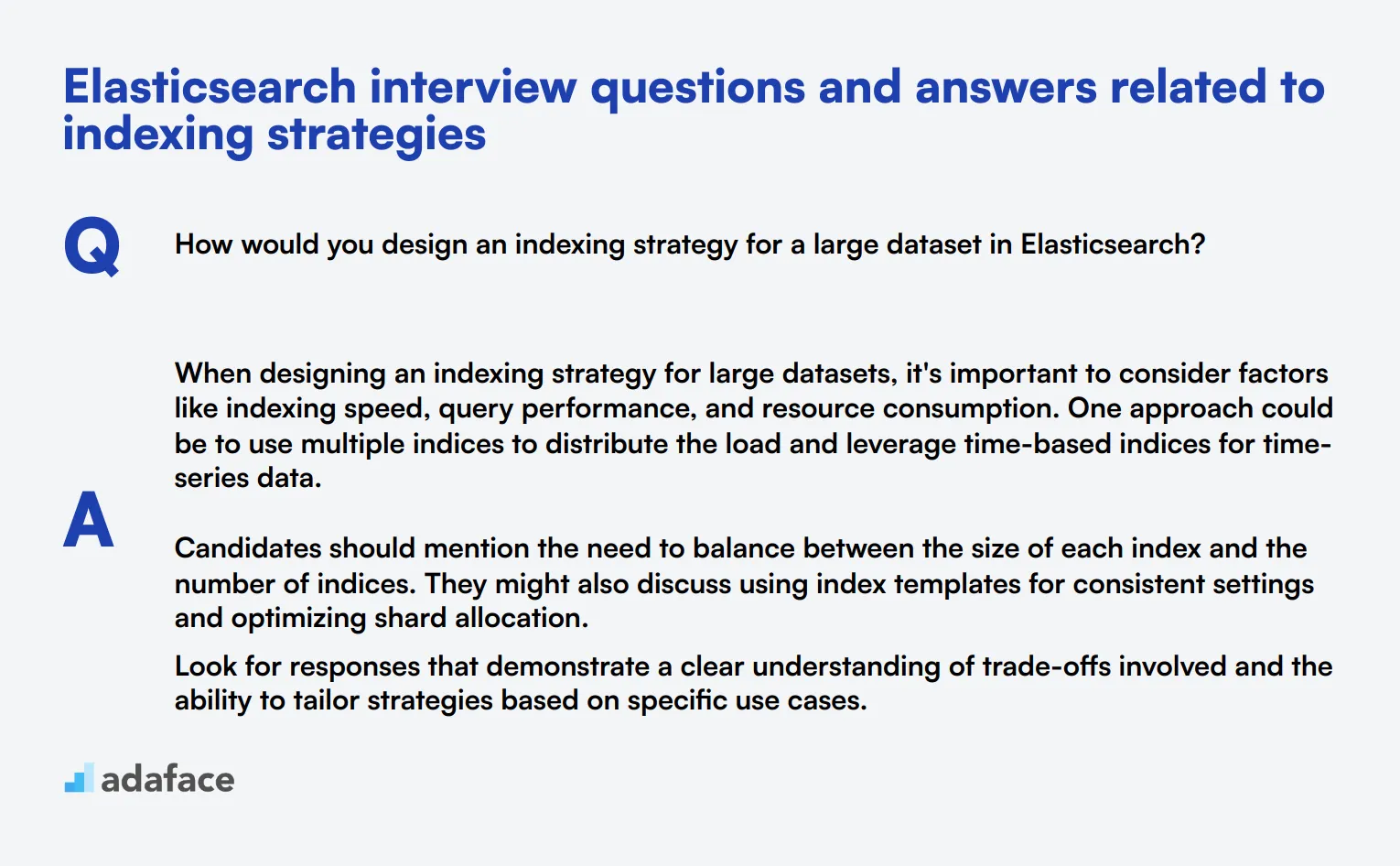
To ensure your candidates have a solid grasp on how to effectively manage and optimize Elasticsearch indexing, ask them some of these critical interview questions. These questions will help you gauge their practical understanding and approach to various indexing strategies.
1. How would you design an indexing strategy for a large dataset in Elasticsearch?
When designing an indexing strategy for large datasets, it's important to consider factors like indexing speed, query performance, and resource consumption. One approach could be to use multiple indices to distribute the load and leverage time-based indices for time-series data.
Candidates should mention the need to balance between the size of each index and the number of indices. They might also discuss using index templates for consistent settings and optimizing shard allocation.
Look for responses that demonstrate a clear understanding of trade-offs involved and the ability to tailor strategies based on specific use cases.
2. What are some indexing best practices you follow in Elasticsearch?
Some best practices for Elasticsearch indexing include: using appropriate analyzers for text fields, setting up index templates to maintain consistency, and defining mappings to avoid dynamic mapping overhead.
Candidates might also mention optimizing shard settings based on the expected data volume and using bulk indexing to improve performance. Monitoring and adjusting settings based on query patterns and load can also be crucial.
Ideal answers should showcase a comprehensive understanding of these best practices and how they contribute to maintaining efficient and scalable indices.
3. How do you handle different types of data in Elasticsearch indices?
Handling different types of data in Elasticsearch requires creating specific mappings for various data types like text, keyword, date, and numeric fields. This helps ensure that Elasticsearch processes and queries the data efficiently.
Candidates should also discuss the importance of using appropriate data types to optimize storage and search performance. For instance, using 'keyword' data type for structured fields and 'text' for unstructured text data.
Look for answers that show a balanced approach to defining mappings tailored to the data and query requirements.
4. What is your approach to managing index lifecycle policies in Elasticsearch?
Index lifecycle management (ILM) in Elasticsearch helps automate the process of managing the indices' lifecycle, from creation to deletion. My approach involves defining policies that specify phases such as hot, warm, cold, and delete, to manage data depending on its age and usage.
Candidates should mention the importance of setting up appropriate transitions between phases to balance cost and performance. They might discuss using rollover indices to manage large datasets and ensure efficient storage.
Strong answers will reflect an understanding of how ILM policies contribute to sustainable and optimized cluster performance.
5. How do you optimize indexing performance in Elasticsearch?
Optimizing indexing performance can involve several strategies, such as using bulk indexing to reduce the overhead of individual requests, adjusting refresh intervals, and configuring appropriate shard and replica settings.
Candidates might also talk about tuning the JVM heap size and monitoring resource utilization to ensure that the Elasticsearch cluster operates efficiently. Adjusting the number of replicas based on read and write patterns can also be crucial.
Look for responses that demonstrate practical experience in optimizing indexing performance and an understanding of resource management in Elasticsearch.
6. How would you handle schema changes and reindexing in Elasticsearch?
Handling schema changes often requires reindexing, which involves creating a new index with the updated schema and then reindexing the data from the old index to the new one. This process can be managed using the reindex API in Elasticsearch.
Candidates should discuss minimizing downtime by performing reindexing in phases and using aliases to switch traffic from the old index to the new index seamlessly. They might also mention using index templates to manage schema changes more efficiently.
Ideal responses will showcase a methodical approach to schema changes and a clear plan for ensuring data integrity during the reindexing process.
7. How do you ensure that your Elasticsearch indices are optimized for search performance?
Ensuring optimal search performance involves using appropriate analyzers and mappings, setting up index templates, and tuning shard and replica settings based on the data and query load.
Candidates might also discuss optimizing query performance by using filters instead of queries where possible, leveraging caching, and using appropriate query types like 'match' or 'term' based on the use case.
Look for answers that reflect a balanced approach to both indexing and querying, demonstrating an understanding of how to maintain fast and efficient search capabilities.
8. What steps do you take to troubleshoot indexing issues in Elasticsearch?
To troubleshoot indexing issues, I would start by checking the Elasticsearch logs for any error messages. Common issues can include mapping conflicts, incorrect data formats, or insufficient resources.
Candidates should also mention using the '_cat' APIs to monitor the cluster status and shard allocation. They might discuss analyzing slow logs to identify bottlenecks and using tools like Kibana for visual insights.
Ideal answers will show a systematic approach to diagnosing and resolving indexing issues, with an emphasis on leveraging Elasticsearch's built-in tools and monitoring capabilities.
9. How do you manage and optimize Elasticsearch mappings for different use cases?
Managing mappings involves defining the appropriate data types and analyzers for each field. For example, using 'keyword' for structured fields and 'text' for unstructured data ensures efficient indexing and querying.
Candidates should mention the importance of avoiding dynamic mapping for large datasets to prevent performance issues. They might also discuss using index templates to maintain consistent mappings across indices.
Look for responses that demonstrate a deep understanding of how to tailor mappings to specific use cases and ensure efficient data handling and search performance.
5 Elasticsearch interview questions and answers related to query optimization

To gauge a candidate's expertise in Elasticsearch query optimization, ask them some of these insightful questions. These queries will help you assess their understanding of performance tuning and their ability to optimize search operations. Remember, the best candidates will not only provide technical answers but also demonstrate practical problem-solving skills.
1. How would you approach optimizing a slow-performing Elasticsearch query?
A strong candidate should outline a systematic approach to query optimization. They might mention:
- Analyzing the query structure and complexity
- Using the Elasticsearch explain API to understand how the query is executed
- Checking the mapping and index settings
- Considering the use of filter context instead of query context where appropriate
- Evaluating the need for custom analyzers or tokenizers
- Implementing caching strategies
Look for candidates who emphasize the importance of profiling and benchmarking before and after optimization attempts. They should also mention the significance of understanding the specific use case and data characteristics when optimizing queries.
2. Can you explain the difference between query and filter context in Elasticsearch, and when would you use each?
An ideal answer should cover the following points:
- Query context: Used for full-text search and affects the relevance score. It asks 'How well does this document match?'
- Filter context: Used for exact matches and does not affect the relevance score. It asks 'Does this document match?'
- Filter context is generally faster and can be cached
Look for candidates who can provide examples of when to use each context. For instance, using filter context for date ranges or category filters, and query context for searching user-input text fields. A strong candidate might also mention that combining both contexts can lead to efficient and relevant search results.
3. How do you handle and optimize aggregations in Elasticsearch, especially for large datasets?
A comprehensive answer should include strategies like:
- Using filter aggregations to reduce the dataset before aggregating
- Leveraging date histograms with appropriate intervals for time-based data
- Implementing sampling for approximate results on very large datasets
- Utilizing the composite aggregation for pagination of aggregation results
- Considering the use of pre-computed aggregations for frequently accessed metrics
Pay attention to candidates who mention the importance of monitoring aggregation performance and adjusting shard sizes or replica counts accordingly. They should also be aware of the trade-offs between accuracy and performance when dealing with large-scale aggregations.
4. What strategies would you employ to optimize Elasticsearch for high-cardinality fields?
A knowledgeable candidate should discuss approaches such as:
- Using keyword fields instead of text fields for exact matching
- Implementing field data cache carefully and with limits
- Considering the use of doc values for certain use cases
- Leveraging the terms aggregation with a reasonable size parameter
- Exploring alternatives like the composite aggregation for large-scale, high-cardinality aggregations
Look for candidates who understand the challenges of high-cardinality fields, such as increased memory usage and slower query performance. They should be able to explain the trade-offs of different optimization techniques and when to apply them based on specific use cases and data characteristics.
5. How would you implement and optimize a multi-field search in Elasticsearch?
A strong answer should cover the following points:
- Using the multi_match query type
- Explaining different multi_match query types (best_fields, most_fields, cross_fields)
- Utilizing the tie_breaker parameter to balance relevance across fields
- Considering field boosting to prioritize certain fields
- Implementing fuzziness for error tolerance
Look for candidates who can explain the pros and cons of different multi-field search approaches. They should also mention the importance of understanding the data structure and user intent when designing multi-field searches. A good candidate might also touch on the use of custom analyzers or query expansion techniques to improve search relevance.
8 situational Elasticsearch interview questions with answers for hiring top engineers
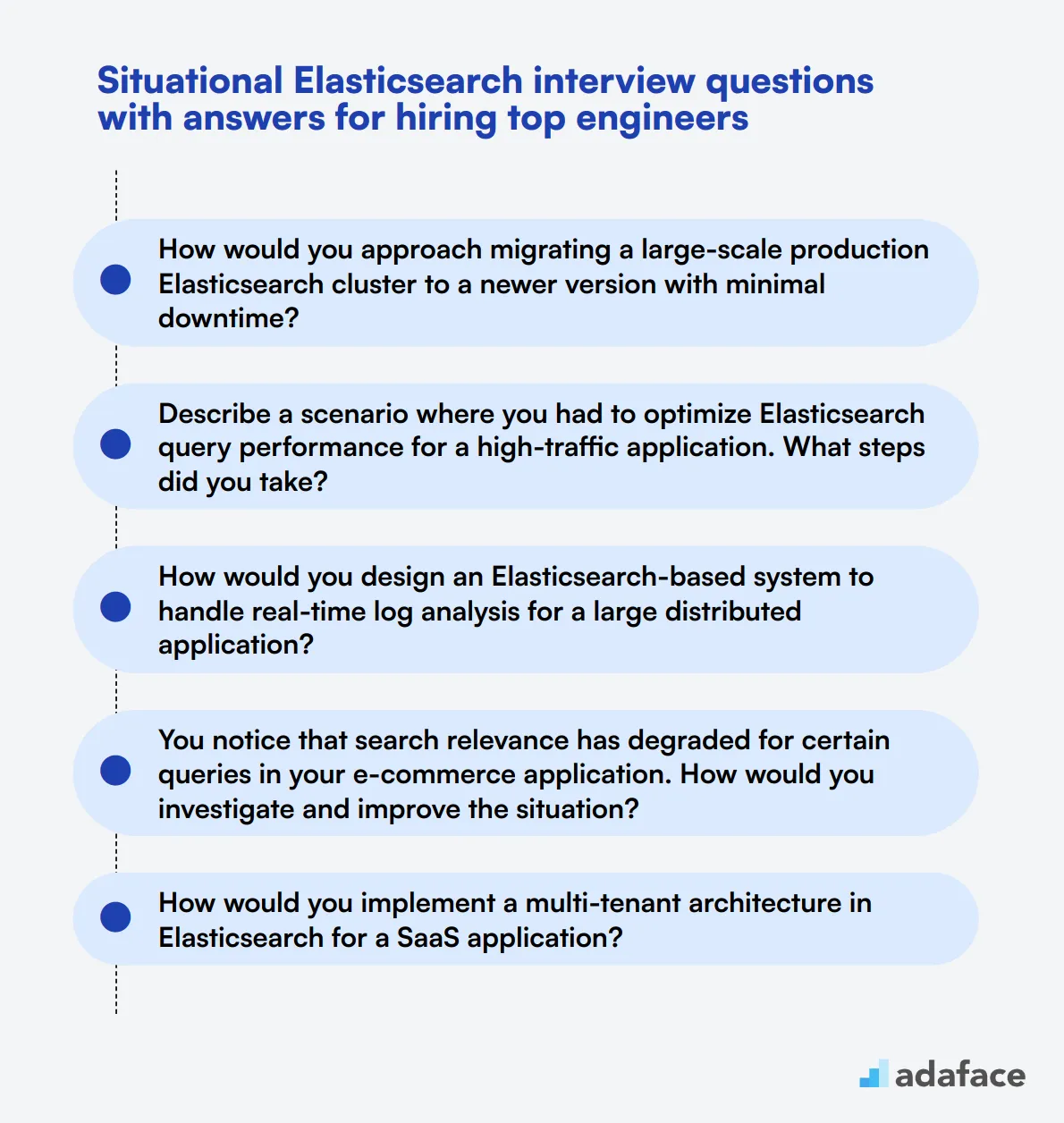
Ready to dive into the world of Elasticsearch interviews? These 8 situational questions will help you assess candidates' real-world problem-solving skills and technical knowledge. Use them to identify top engineers who can navigate the complexities of Elasticsearch in your organization.
1. How would you approach migrating a large-scale production Elasticsearch cluster to a newer version with minimal downtime?
A strong candidate should outline a step-by-step approach that includes:
- Thoroughly reviewing release notes and breaking changes
- Setting up a staging environment to test the upgrade
- Creating a backup of all indices and cluster configuration
- Implementing a rolling upgrade strategy to minimize downtime
- Monitoring cluster health and performance during and after the upgrade
Look for candidates who emphasize the importance of thorough planning, risk mitigation, and having a rollback strategy in case of unexpected issues. They should also mention the need for clear communication with stakeholders throughout the process.
2. Describe a scenario where you had to optimize Elasticsearch query performance for a high-traffic application. What steps did you take?
An ideal response should cover multiple aspects of query optimization:
- Analyzing slow queries using the _profile API or slow query logs
- Optimizing mapping and index settings (e.g., proper field types, index_options)
- Implementing caching strategies (query cache, request cache)
- Using filter context instead of query context where appropriate
- Considering denormalization or custom scoring to improve relevance
Pay attention to candidates who demonstrate a systematic approach to performance optimization and can explain the trade-offs between different strategies. They should also mention the importance of benchmarking before and after optimizations.
3. How would you design an Elasticsearch-based system to handle real-time log analysis for a large distributed application?
A comprehensive answer should address the following points:
- Implementing a robust log ingestion pipeline (e.g., using Logstash or Filebeat)
- Designing an appropriate index structure with time-based indices
- Setting up index lifecycle management for efficient data retention
- Creating dashboards and visualizations in Kibana for real-time monitoring
- Implementing alerts for critical events or anomalies
Look for candidates who consider scalability, performance, and data management aspects. They should also mention strategies for handling sudden spikes in log volume and discuss potential challenges in processing diverse log formats.
4. You notice that search relevance has degraded for certain queries in your e-commerce application. How would you investigate and improve the situation?
A strong candidate should outline a structured approach to diagnosing and improving search relevance:
- Gathering user feedback and analyzing search logs to identify problematic queries
- Using the Explain API to understand how documents are scored for specific queries
- Adjusting query structures (e.g., boosting fields, using function_score or custom_score queries)
- Fine-tuning analyzers and tokenizers to better match user search patterns
- Implementing relevance tuning techniques like learning to rank
Evaluate candidates based on their ability to balance technical solutions with user-centric approaches. They should also mention the importance of A/B testing and continuous monitoring of relevance metrics.
5. How would you implement a multi-tenant architecture in Elasticsearch for a SaaS application?
An effective answer should discuss different approaches and their trade-offs:
- Index-per-tenant: Pros (strong isolation, flexible mappings) and cons (index overhead)
- Shared index with a tenant field: Pros (efficient resource use) and cons (potential data leaks)
- Hybrid approach: Using both dedicated and shared indices based on tenant requirements
The candidate should also address:
- Security considerations (role-based access control, field- and document-level security)
- Performance optimizations (shard allocation awareness, custom routing)
- Scalability challenges and solutions for handling a growing number of tenants
Look for responses that demonstrate understanding of the complexities involved in multi-tenant systems and the ability to make design decisions based on specific use cases and requirements.
6. Describe how you would implement a near real-time product recommendation system using Elasticsearch.
A comprehensive answer should cover the following aspects:
- Designing an appropriate index structure to store user behavior and product data
- Implementing real-time data ingestion for user interactions (e.g., views, purchases)
- Using Elasticsearch's more-like-this query or vector search capabilities for similarity matching
- Incorporating collaborative filtering techniques using aggregations
- Implementing a scoring mechanism that combines multiple factors (e.g., similarity, popularity, recency)
- Setting up periodic batch updates for long-term trends and cold-start recommendations
Evaluate candidates based on their ability to leverage Elasticsearch features for recommendation systems while considering scalability and real-time performance. They should also discuss strategies for handling data sparsity and the cold-start problem.
7. How would you approach implementing a fuzzy autocomplete feature using Elasticsearch?
A strong response should include the following elements:
- Using the completion suggester for fast prefix matching
- Implementing edge n-grams for partial word matching
- Utilizing the match_phrase_prefix query for last-term completion
- Incorporating fuzziness using the fuzzy query or phonetic plugins
- Optimizing for performance through appropriate index settings and caching
Look for candidates who can explain the trade-offs between different approaches and discuss how to balance speed, accuracy, and resource usage. They should also mention strategies for handling misspellings and language-specific challenges.
8. Describe how you would implement a geo-aware search feature in Elasticsearch for a location-based service.
An ideal answer should cover these key points:
- Using appropriate geo_point or geo_shape field types for storing location data
- Implementing geo_distance queries for radius-based searches
- Utilizing geo_bounding_box queries for map-based searches
- Incorporating geo_distance sort for ordering results by proximity
- Optimizing performance using geohash_grid aggregations for clustering results
- Considering the earth's curvature in distance calculations
Evaluate candidates based on their understanding of Elasticsearch's geo-capabilities and their ability to apply them to real-world scenarios. They should also discuss considerations for handling large datasets and maintaining search performance as the number of locations grows.
Which Elasticsearch skills should you evaluate during the interview phase?
Evaluating a candidate's Elasticsearch skills during an interview is crucial, but it’s important to remember that one conversation won't uncover everything about their capabilities. However, focusing on the right core skills can help interviewers gauge a candidate's potential effectively.
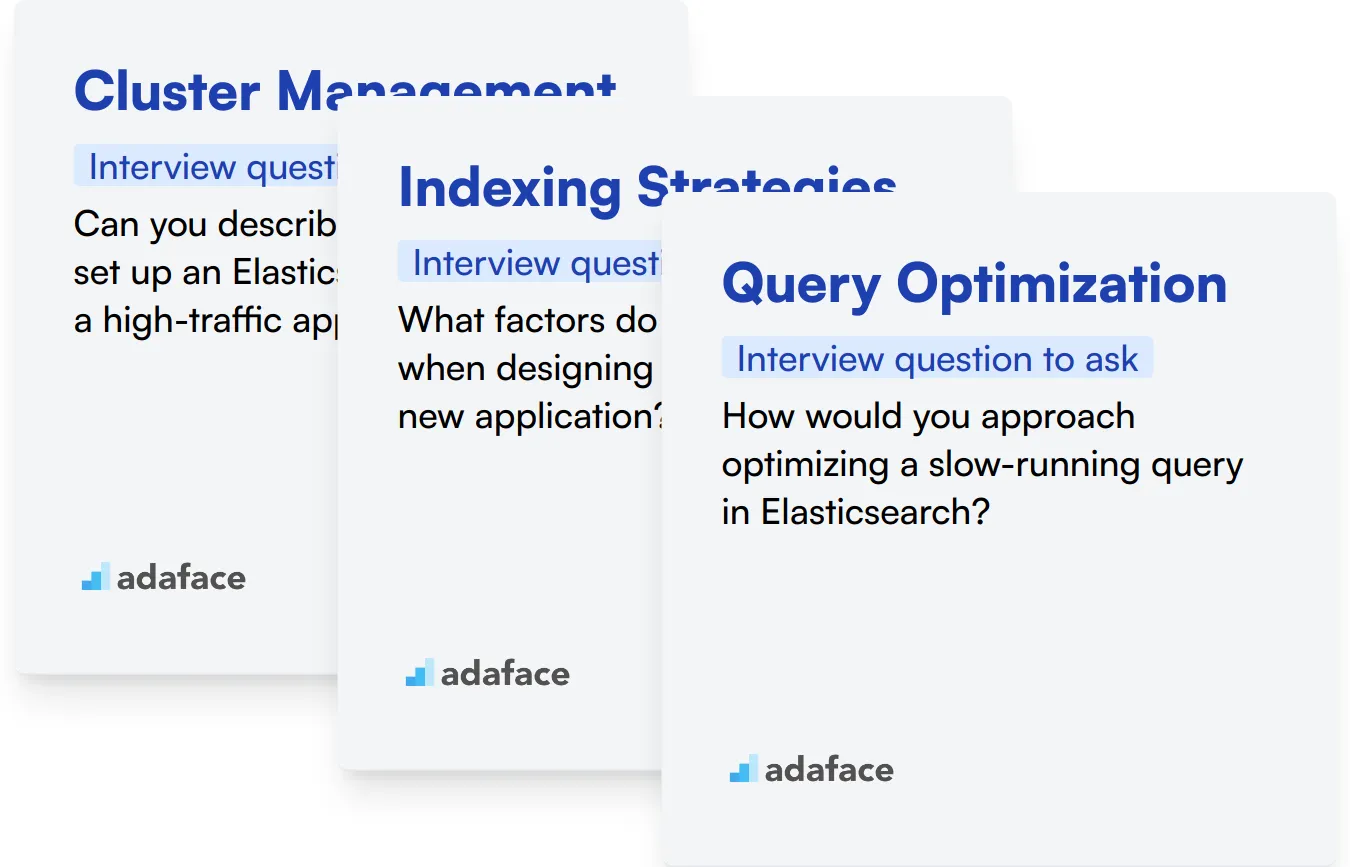
Cluster Management
Consider using an assessment test that includes multiple-choice questions on cluster management, which can help filter candidates based on their understanding of this critical area. You can find relevant tests in our library, such as the Elasticsearch Assessment Test.
You can also assess this skill by asking specific interview questions that delve into their practical experience with cluster management.
Can you describe how you would set up an Elasticsearch cluster for a high-traffic application?
When asking this question, look for candidates to explain their approach to node configuration, sharding strategies, and how they would monitor and maintain the cluster's health.
Indexing Strategies
An assessment test focused on indexing strategies can help identify candidates with the right expertise. Our Elasticsearch Assessment Test includes questions specifically related to this skill.
Further, you can ask targeted questions to evaluate their knowledge about indexing techniques.
What factors do you consider when designing an index for a new application?
Pay attention to their understanding of field types, analyzers, and how these choices can affect search performance and storage efficiency.
Query Optimization
To assess this skill, consider using an MCQ test that includes questions on query optimization strategies. Relevant tests can help identify candidates with the right skills, such as the Elasticsearch Assessment Test.
You can also pose specific questions during the interview to evaluate their practical knowledge and experience.
How would you approach optimizing a slow-running query in Elasticsearch?
Look for their ability to discuss techniques such as filter caching, using the right query types, and indexing strategies that can improve performance.
Strategic Tips for Leveraging Elasticsearch Interview Questions
Before you begin utilizing the Elasticsearch interview questions provided, here are some strategic tips to enhance the interviewing process and ensure you effectively assess candidate capabilities.
1. Incorporate Skill Tests Prior to Interviews
Incorporating skill tests after sourcing candidates but before the interview stage can significantly streamline the recruitment process. These tests help in pre-assessing the technical capabilities of the applicants, ensuring only qualified candidates proceed to the interview phase.
For Elasticsearch roles, consider using Elasticsearch Test from Adaface to evaluate candidates' proficiency. This can be complemented with tests like Data Engineer Test or Data Analysis Test depending on the job's specific requirements.
Using these tests helps in identifying candidates who possess the necessary skills and knowledge, thus saving time during interviews and allowing deeper exploration of candidates' expertise and problem-solving abilities.
2. Carefully Select and Compile Interview Questions
Time during interviews is limited, making it essential to select and compile questions that effectively evaluate the important aspects of a candidate’s capabilities. Focus on questions that probe deeply into critical skills needed for the role.
Explore other related skills by integrating questions from areas such as Data Structures, REST API, or consider assessing soft skills like problem solving and communication to get a holistic view of the candidate's abilities.
3. Emphasize Follow-Up Questions During Interviews
Using pre-set interview questions is a good start, but asking insightful follow-up questions is key to understanding a candidate's true depth of knowledge and suitability for the role.
For instance, if a candidate describes their experience with scaling Elasticsearch clusters, a good follow-up might be, 'Can you walk me through the steps you took to diagnose and resolve conflicts during the scaling process?' This question helps gauge their problem-solving approach and practical knowledge.
Using Skill Tests to Confirm Elasticsearch Expertise for Effective Hiring
When aiming to hire professionals with proficient Elasticsearch skills, verifying these abilities accurately is key. A practical way to assess these skills is through targeted skill tests. Consider using the Elasticsearch Test from Adaface to ensure candidates meet your requirements.
After candidates complete the skills test, you can efficiently shortlist the top performers for interviews. To further streamline your hiring process, invite candidates to interviews directly through the Adaface Sign-Up Portal or explore additional resources on our Online Assessment Platform.
Elasticsearch Test
Download Elasticsearch interview questions template in multiple formats
Elasticsearch Interview Questions FAQs
Elasticsearch interview questions help evaluate a candidate's practical knowledge and problem-solving skills with this powerful search engine.
Elasticsearch interviews should cover general concepts, indexing strategies, query optimization, and situational problem-solving.
Junior candidates should be tested on basic concepts and practical skills, while senior candidates should handle advanced scenarios and architectural questions.
Situational questions can involve real-world problem scenarios to understand how a candidate approaches and solves complex issues.
Questions for junior developers focus on fundamentals, while mid-tier and senior engineers face questions on advanced techniques and optimization.
Indexing and query optimization questions are crucial as they test a candidate’s ability to manage and retrieve data efficiently in Elasticsearch.

40 min skill tests.
No trick questions.
Accurate shortlisting.
We make it easy for you to find the best candidates in your pipeline with a 40 min skills test.
Try for freeRelated posts
Free resources




